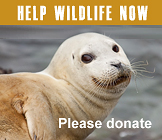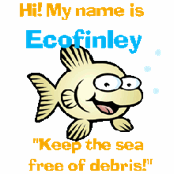Oct 2015
Mystery season continues: trick or treat for harbor seal pups?
Oct/31/15 07:47 AM
September and October, the usual months in South Puget Sound when newly weaned harbor seal pups strike out on their own, have proven to be spooky for a number of marine mammal stranding networks. Responses to weaned pups are way down - and in typically seal-busy areas like West Seattle, First Responders have been essentially idle. However, Seal Sitters volunteers faithfully continue to enter time on our online calendar and wonder when their phone will ring, hoping to help protect a seal pup.
Seal Sitters’ hotline (206-905-SEAL) has been eerily silent, with phone reports down drastically. Last October, hotline operators fielded 54 calls, 24 of which were out-of-area calls. Seal Sitters routinely receives calls from other regions of Puget Sound which we forward on to the appropriate network. In October of 2015, we have handled only 7 calls, including 3 out-of-area.
In September and October of 2014, Seal Sitters responded to 60 pinnipeds - seals and sea lions, but by far the vast majority were seal pups. This year for the two month period, we have a combined total of only 14, mostly to dead newborn animals early in the season. The average September responses for the previous 4 years is 36. The average for October for the previous 4 years is 42. These numbers include pinnipeds, dead or alive.
Scratching our heads over the lack of pups resting on shore or even seen swimming around the area, Seal Sitters’ Lead Investigator reached out to other stranding networks, curious if they were experiencing a similarly slow season. Our informal poll has indicated that response numbers are down region-wide and other network coordinators are perplexed as well. Port Townsend, Edmonds and Snohomish/King Counties have also had very few responses this year (pupping season varies across Puget Sound - view a pupping season map here).
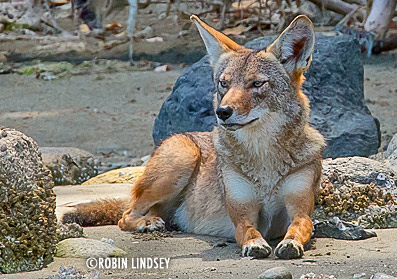 So, what does this all mean? According to our consulting marine mammal biologist, it does not necessarily indicate dire straits for seal pups. Area rookeries had normal birth numbers and there was no dramatic increase in newborn mortality. The one exception has been an unusual and extensive coyote predation of seal pups at a historic South Puget Sound island haulout (shown at right, a well-fed coyote waits patiently for his next meal).
So, what does this all mean? According to our consulting marine mammal biologist, it does not necessarily indicate dire straits for seal pups. Area rookeries had normal birth numbers and there was no dramatic increase in newborn mortality. The one exception has been an unusual and extensive coyote predation of seal pups at a historic South Puget Sound island haulout (shown at right, a well-fed coyote waits patiently for his next meal).
Perhaps pups are healthy enough this season that they don’t have to come ashore on busy beaches. Instead, they have the strength to swim on and find quieter locations to rest. The good news is we are not having high numbers of emaciated pups on shore in West Seattle like the past few seasons.
On the flip side, the mammal-eating transient orcas have been visiting Puget Sound more frequently this year. Some theorize that they could have had some impact on pup populations. Weaker pups are easy prey for killer whales.
Is climate change affecting marine life and foraging habits? Undoubtedly. Are forage fish numbers dwindling? Certainly. Watch a video here about the importance of forage fish to marine mammals, salmon and other species. Please check back as we continue our inquiry with marine mammal biologists and scientists to further investigate possible root causes of such a haunting season.
Seal Sitters’ hotline (206-905-SEAL) has been eerily silent, with phone reports down drastically. Last October, hotline operators fielded 54 calls, 24 of which were out-of-area calls. Seal Sitters routinely receives calls from other regions of Puget Sound which we forward on to the appropriate network. In October of 2015, we have handled only 7 calls, including 3 out-of-area.
In September and October of 2014, Seal Sitters responded to 60 pinnipeds - seals and sea lions, but by far the vast majority were seal pups. This year for the two month period, we have a combined total of only 14, mostly to dead newborn animals early in the season. The average September responses for the previous 4 years is 36. The average for October for the previous 4 years is 42. These numbers include pinnipeds, dead or alive.
Scratching our heads over the lack of pups resting on shore or even seen swimming around the area, Seal Sitters’ Lead Investigator reached out to other stranding networks, curious if they were experiencing a similarly slow season. Our informal poll has indicated that response numbers are down region-wide and other network coordinators are perplexed as well. Port Townsend, Edmonds and Snohomish/King Counties have also had very few responses this year (pupping season varies across Puget Sound - view a pupping season map here).

Perhaps pups are healthy enough this season that they don’t have to come ashore on busy beaches. Instead, they have the strength to swim on and find quieter locations to rest. The good news is we are not having high numbers of emaciated pups on shore in West Seattle like the past few seasons.
On the flip side, the mammal-eating transient orcas have been visiting Puget Sound more frequently this year. Some theorize that they could have had some impact on pup populations. Weaker pups are easy prey for killer whales.
Is climate change affecting marine life and foraging habits? Undoubtedly. Are forage fish numbers dwindling? Certainly. Watch a video here about the importance of forage fish to marine mammals, salmon and other species. Please check back as we continue our inquiry with marine mammal biologists and scientists to further investigate possible root causes of such a haunting season.
Seal pup Little Dipper returned to the wilds of Puget Sound
Oct/17/15 08:01 AM
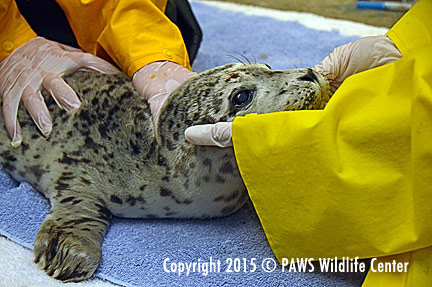
Little Dipper’s stint of rehabilitation at PAWS Wildlife Center (intake exam photo at left) was a bit longer than a typical two-month duration because he was slow to pack on weight. A newborn seal pup in rehab must be taught to eat whole fish since they are not able to learn from other seals in the wild. When finally released on October 9th, he weighed over 30 kgs (66+ lbs) - a true blubberball! The pup weighed only about 18 lbs when taken in for stabilization and treatment.
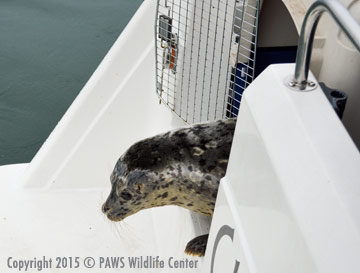
Little Dipper was released, along with another rehabilitated seal pup, near a harbor seal haulout. The photo at right shows Little Dipper emerging from his kennel on the boat transom, seconds before plunging into the water and swimming off. We so hope that these two young pups navigate the waters successfully and thrive together in the vast expanse of Puget Sound - and find safety when resting onshore.
Seal Sitters MMSN extends heartfelt thanks to the dedicated staff at PAWS for giving Little Dipper a second chance at life and generously providing photos to share with volunteers and the public.
If you see a seal pup (or any marine mammal) with a tag and are able to get the number thru binoculars or with a telephoto lens at a distance, please forward the location information and photos to Seal Sitters.

